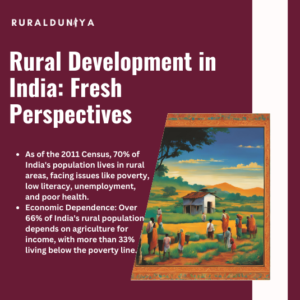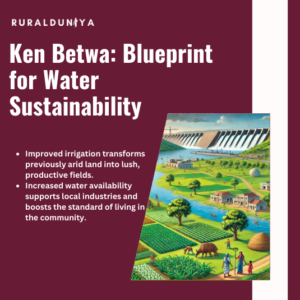Urban rural areas shape the world differently. Cities are busy centers of progress and growth, while villages connect us to nature, traditions and farming.
Together, they balance modern and traditional life, creating a unique blend that supports development.
Urban Rural: Bridging Two Worlds
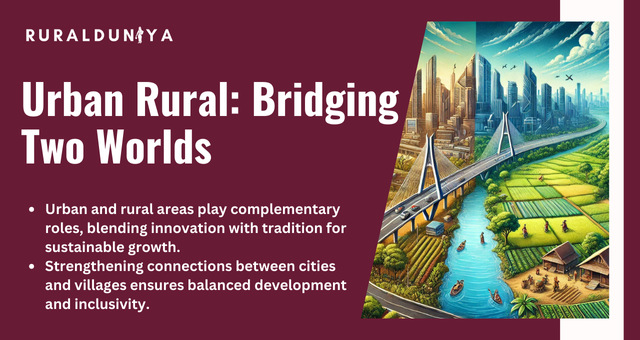
Urban rural areas, though distinct in characteristics, are interdependent pillars of any nation’s framework. Urban centers are defined by their dense populations, advanced infrastructure, and economic vibrancy.
In contrast, rural areas are characterized by sparse populations, primary economic activities like agriculture, and a close-knit community lifestyle. Understanding their differences, connections, and challenges provides insights into balanced regional development.
Urban vs. Rural: Key Differences in Everyday Life and Opportunities
Urban areas are marked by extensive infrastructure, higher population density, and industrialization. Examples include cities like Mumbai and Delhi, where industries thrive, and skyscrapers dominate.
Rural regions, such as villages in Madhya Pradesh, primarily rely on agriculture and natural resources.
Urban areas are full of buildings, roads and industries. For example, cities like Delhi and Mumbai are known for jobs in IT and finance. In contrast, rural areas like villages in Rajasthan depend on farming and small-scale businesses.
These differences affect education, healthcare and jobs, making urban and rural lifestyles quite distinct.
Urban Rural Population in India: Learning from Recent Data and Trends
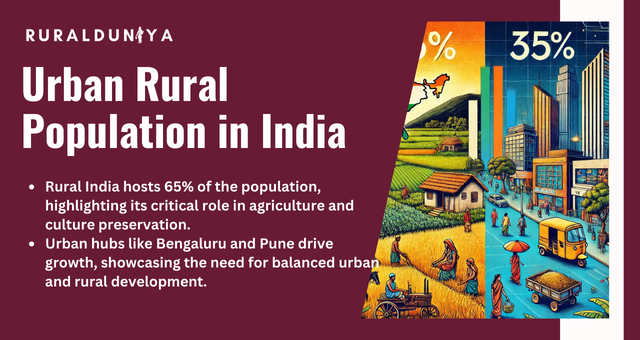
India, home to 1.4 billion people, has a diverse population distribution. According to the 2021 Census, approximately 65% of the population resides in rural areas, while 35% inhabit urban regions.
States like Uttar Pradesh lead in rural populations, while Maharashtra showcases significant urban concentration.
India is home to over a billion people, with two-thirds living in rural areas. For example, villages in Uttar Pradesh and Bihar have large populations, while urban areas like Bengaluru and Pune are growing fast due to jobs and education.
This shift shows the importance of improving facilities in both areas to support the population.
Urban, Rural and Suburban Areas: What Makes Them Different?
Urban areas are crowded cities with schools, hospitals and industries. Rural areas have open fields and depend on farming. Suburban areas, like Gurugram, combine the two, offering modern housing with more space.
This mix attracts people looking for a better quality of life near urban hubs.
Five Key Differences Between Urban and Rural Living
- Population: Cities like Mumbai are packed, but villages like those in Himachal Pradesh are spacious.
- Facilities: Urban areas have malls and hospitals, while rural areas may have limited access to basic amenities.
- Jobs: Urban jobs are diverse, from IT to banking, but rural areas focus on agriculture and small trades.
- Lifestyles: Cities offer fast-paced lives, but rural living is simpler and more connected to nature.
- Education: Cities have prestigious schools, while rural areas often rely on government-run institutions.
Urban and Rural Life: Comparing Benefits and Challenges
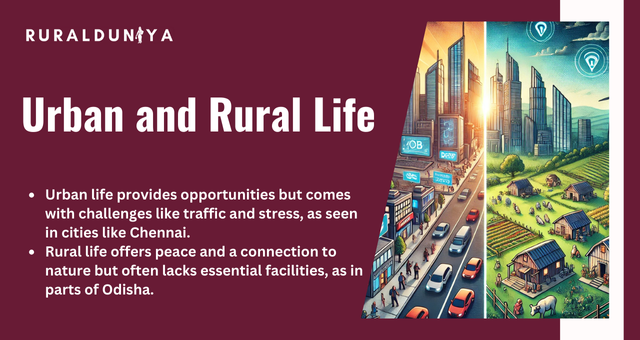
Living in a city means access to jobs, entertainment and healthcare, but it can also bring traffic and stress. For example, Chennai offers opportunities in the tech industry, but its traffic congestion is a major issue.
Rural life is peaceful and close to nature, but it often lacks basic facilities, like in remote parts of Odisha.
Suburban Living: The Best of Both Worlds?
Suburban areas like Noida offer the quiet of rural life with the benefits of urban infrastructure. These areas are popular with families because they provide good schools, green spaces and job opportunities nearby. They act as a middle ground, balancing city and village life.
Is Your Location Urban or Rural? Tools You Can Use
You can use Google Maps to figure out if a place is rural or urban. For instance, zooming into rural Punjab shows fields and open spaces, while urban Delhi has a dense layout of buildings and roads. Census tools can also help classify areas based on their population and facilities.
What Does Urban and Rural Mean? Simple Definitions
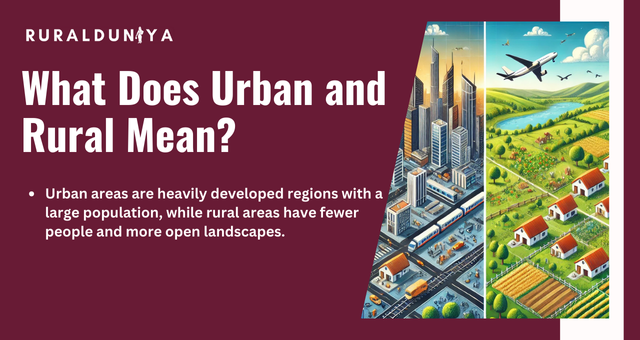
Urban areas are heavily developed regions with a large population, while rural areas have fewer people and more open landscapes.
Urban areas are cities with many people, businesses and modern facilities like metros and airports. Rural areas are villages with fewer people, farms and basic services. For example, New York City is urban, while the Scottish Highlands are rural.
Definitions may differ by country, but the core ideas remain the same.
Why People Move from Villages to Cities
Many people leave villages for cities like Hyderabad or Mumbai for better jobs, schools and healthcare. This migration improves living standards but also creates problems like crowded cities and fewer workers in villages. Balancing development in both areas can solve these challenges.
Urban vs. Rural: A Global Look at Population Trends
Urban areas are growing worldwide. Countries like China have megacities like Shanghai, while rural areas in Africa focus on farming. Globally, over half the population lives in cities. However, rural regions still play a big role in food production and environmental care.
India’s Urban Rural Ratio: What It Tells Us
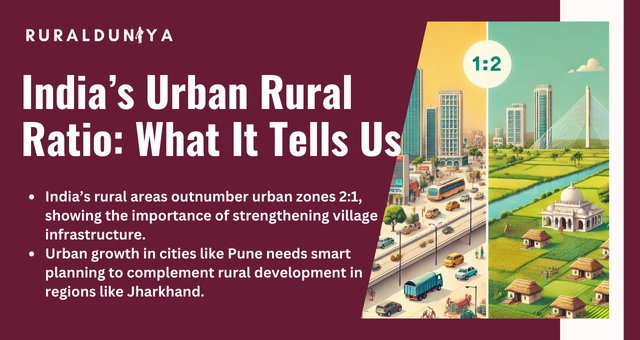
In India, for every urban area like Pune, there are twice as many rural regions, like villages in Jharkhand. This ratio shows the need for better facilities in villages and smart urban planning to handle the growing city population.
Tribal Communities in Urban and Rural Areas
Tribal groups like the Santhals in Jharkhand mainly live in rural areas and forests. They rely on natural resources and have unique traditions. Including their needs in development plans ensures their culture and livelihoods are protected.
Urban and Rural Unemployment: Different Challenges
Cities like Bengaluru face unemployment among educated youth looking for tech jobs, while rural areas, such as drought-hit Maharashtra, struggle with seasonal work. Supporting both types of workers through skill training and better opportunities can reduce unemployment.
Urban Rural Inequality: Closing the Gap
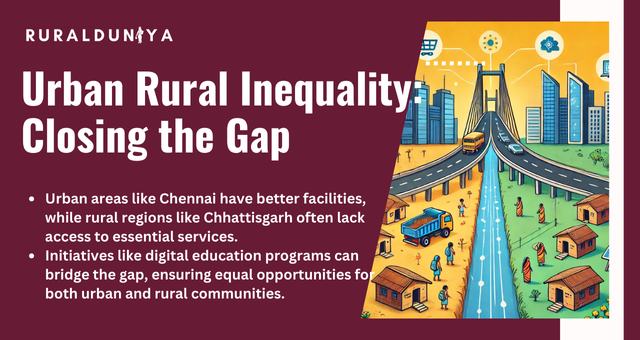
Urban areas like Chennai have better access to schools, hospitals and jobs compared to rural areas like Chhattisgarh. Programs like digital education in rural schools can reduce this gap and give everyone equal opportunities.
Urban Rural Fringe: Where City Meets Village
Places like Hyderabad’s outskirts are a mix of urban and rural life. These areas are ideal for building industries and housing projects but need careful planning to avoid conflicts over land use.
Bridging the Urban Rural Divide
Villages need better transport and services to match urban conveniences like metro systems. Initiatives like better road connectivity through PMGSY help bring rural and urban areas closer.
Connecting Urban and Rural Areas
Urban markets rely on rural areas for fresh produce, like apples from Himachal Pradesh. Improving these connections with better transport and technology can benefit both regions, boosting trade and income.
Building Strong Urban and Rural Communities
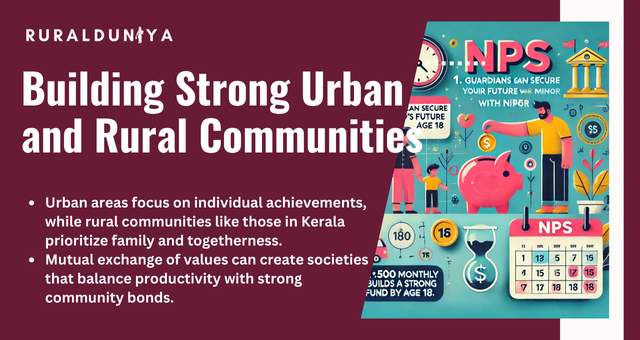
City neighborhoods often focus on work and individual success, while villages like those in Kerala emphasize family and community ties. Learning from each other can create balanced, supportive societies.
Housing Solutions for Remote Rural Communities
Canada’s Northern Indigenous Housing Strategy focuses on eco-friendly homes and renewable energy for remote areas. These solutions are sustainable and respect cultural needs, setting an example for other regions.
Conclusion: Creating Harmony Between Urban and Rural Areas
Both urban rural areas are essential for a balanced world. By improving facilities, creating jobs and respecting each other’s strengths, we can ensure everyone has a chance to thrive, no matter where they live.
FAQs
What is the main difference between urban and rural areas?
Urban areas are cities with many people, industries and advanced facilities like hospitals and schools. Rural areas are villages with fewer people, more open spaces and a focus on farming and nature.
Why do people move from rural areas to urban areas?
People move to cities for better jobs, education and healthcare. For example, many move to cities like Bengaluru for IT jobs and modern facilities.
How can I tell if my location is rural or urban?
You can use Google Maps. Urban areas have dense roads and buildings, while rural areas show more open spaces and fields.
What are suburban areas and how are they different?
Suburban areas are located between cities and villages. They offer modern housing and schools but have more space and less congestion than cities. An example is Noida near Delhi.

Nishank is a social impact enthusiast with a solid foundation in public policy, micro-enterprise, and agribusiness. Growing up in a farmer’s family has given him a profound connection to rural communities, fueling his passion to empower people towards self-reliance. He completed his undergraduate studies at the Delhi University and earned a master’s degree in Rural Management from National Institute of Rural Development & Panchayati Raj in Hyderabad.

